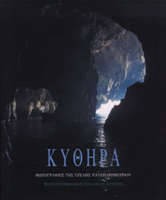Kythera.

Author: Chadjidimitriou Tzeli
When Published: 2000, 2001
Publisher: Crete University Press
Available:
http://www.cup.gr/en/catalogue/book.asp?bookID=269
Description:22x26 cm, 112 pg, colored
ISBN: 960-524-119-6
www.odoiporikon.com
Email Tzeli, here
KYTHERA
Bilingual edition (Greek, English)
Pictures and views of the sea. The waters and the ruins – signs of a long-gone human presence, which measured itself with myth and reality, faced the elements of nature, created, and then abandoned… The human presence dominates, by conscious design of the photographer.
“Kythera” magnetically draw the photographic lens to those moments of nature and light which give off silence. The book is in search of the soul of the island, it stops at local history, going through travellers’ writings and monks’ chronicles, it persistently demands to bring the true island to the surface.
«Elle vient, elle approche, elle glisse amoureusement sur les flots divins qui ont donné le jour à Cythérée... Mais que dis-je ? devant nous, là-bas, à l'horizon, cette côte vermeille, ces collines empourprées qui semblent des nuages, c'est l'île même de Vénus, c'est l'antique Cythère aux rochers de porphyre : ??????? ?????????? ... ... (????) Aujourd'hui cette île s'appelle Cérigo, et appartient aux Anglais.». This extract from a text by Gerard de Nerval gives the tone of Tzelli Chatzidimitriou’s photographic choices: Cerigo with its ‘caves where the waves dive in stormy weather”, the ‘deserted look of the coastline’, the ruined walls of abandoned houses, the ‘small church of Mertidia” from which ‘the so-called Algerian pirates seized everything they could’.
The book is a result of Tzeli’s exciting acquaintance with Kythera. Her excursion to untrodden parts of the island, where history has remained graven on the stone walls and the remote beaches, away from the influence of modern life, have shown her the way to the untouched soul of Kythera. The winter with the strong winds, the spring in Karavas and in Mitata create images which meet together with the half-erased wall paintings of the churches. Beside them, unique architectural forms and unforgettable views. And above all, the colours of the sea and the rocks, hidden beaches, sea caves, a deep blue, and the foam of the sea, pure white, gives birth to Aphrodite and brings the myth to back to life.
The travellers’ texts and the monks’ chronicles allow the reader to imagine Gerard de Nerval’s voyage, to learn about the shipreck of the Mentor and the French revolution through the everyday life of the local inhabitants of the period. The music of Marisa Koch, the prologue to this book, surrounds the images like the clouds which cover the island in order to hide Aphrodite’s nudity and her secret loves. “Fata Morgana”, Nikos Kavvadias’ mirage and the exciting setting to music by Marisa Koch lead the reader on to the eternal myth of Kythera.